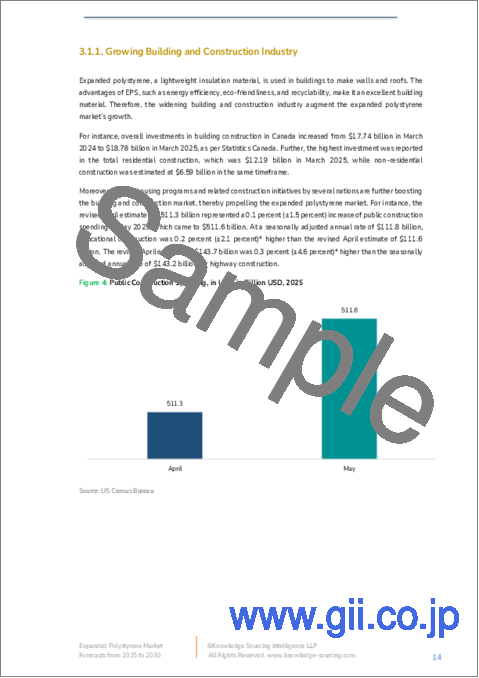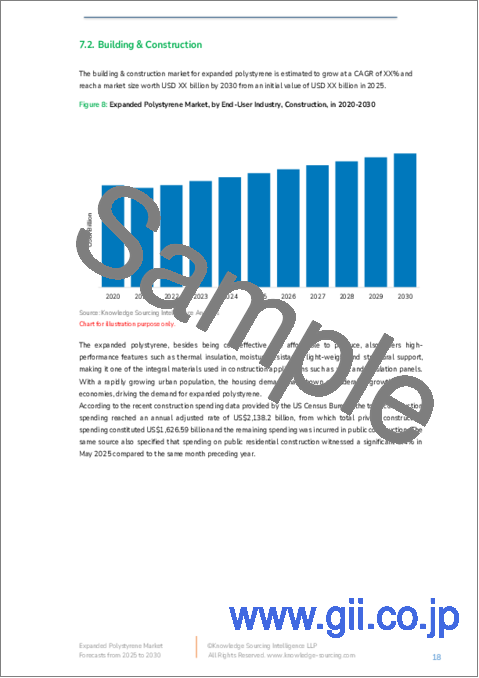|
|
市場調査レポート
商品コード
1521090
発泡スチロール(EPS)市場 - 2024年から2029年までの予測Expanded Polystyrene (EPS) Market - Forecasts from 2024 to 2029 |
||||||
カスタマイズ可能
|
|||||||
| 発泡スチロール(EPS)市場 - 2024年から2029年までの予測 |
|
出版日: 2024年06月20日
発行: Knowledge Sourcing Intelligence
ページ情報: 英文 142 Pages
納期: 即日から翌営業日
|
全表示
- 概要
- 目次
発泡スチロール(EPS)市場は予測期間中にCAGR 3.38%で成長し、2024年の推定値63億8,900万米ドルから2029年には75億4,400万米ドルに達すると予測されています。
発泡スチロール(EPS)市場は予測期間中に大きな成長が見込まれます。アジア太平洋地域は、包装分野と建設分野の旺盛な需要から恩恵を受け、主要市場になると予想されます。この市場の成長に関連する新たな要因には、以下のようなものがあります。増え続ける世界人口とライフスタイルの変化により、「グリーン」商品や「フェアトレード」のコンセプトのような高品質で付加価値の高い商品へのニーズが高まっています。しかし、製品の入手性の高さや環境上の制約といった制約が、市場の成長を鈍らせ続けています。しかし、こうした要因の中、バイオベースのポリスチレンの必要性の高まりとEPSの新たな用途の出現により、市場の成長が見込まれています。この市場の成長を促進している要因は他にもあります。
都市人口が発泡スチロール(EPS)の市場成長に多大な貢献をしているのです。都市化の進展に伴い、包装材や断熱材を可能な限り効率的に使用することが第一の課題となっています。TheraplastのEPS製品は断熱性に優れ、環境にも優しいため、そのような要求に応えるのに理想的です。また、エレクトロニクス、自動車など様々な分野の技術開発により、高品質の包装材料に対する需要が高まっています。すでに拡大しているeコマースの動向は、電気自動車の人気の高まりによって補完され、これもEPSの需要を促進しています。したがって、EPS市場はこれら2つのセクターからの支援により、持続的な成長を遂げる可能性が高いです。
EPS市場はまた、環境に優しい包装材や建材に対する世界人口のニーズの高まりも背景にあります。世界中の人々が環境保護に対する意識を高め、エコロジーに配慮した商品を好むようになっています。そのため、EPSは密度が低く、環境意識の高い企業にとってメリットがあることから、包装材として好まれています。建築では、EPSは断熱材としても使われ、経済的でもあります。つまり、エネルギー効率と環境に配慮した実践への意識が、EPSの使用を促進する要因にもなっています。EPAの実施や支援、EPSの廃棄物削減のための対策を打ち出す政府も増えており、EPS市場はこうした対策から利益を得ると予想されます。
新興市場からのニーズも、EPS市場の人気に一役買っているもう一つの要因です。最近急速に成長している地域には、人口が都市化している中国やインドがあり、経済が速いペースで成長しているため、包装材や建築材の需要が高まっています。これらの国々の成長要因である中産階級の増加は、現在、包装された商品、ひいてはEPSを要求しています。また、これらの国々で急速に導入されつつある支援インフラは、特に建設プロジェクトにおいて、EPSのより大きな市場を生み出しています。また、徐々にではあるが着実に拡大している新興市場もあり、市場需要の増加に伴い、EPS市場も拡大する機会を得ています。
発泡スチロール(EPS)市場促進要因:
- タイプ別では、ホワイトEPSセグメントが予測期間中に最も急成長する
ホワイトEPSセグメントは、予測期間中、発泡スチロール(EPS)市場で最も急成長する製品タイプになると予想されます。このような成長は、包装分野で使用されるホワイトEPSに対する市場の需要が増え続けていることに起因しています。ホワイトEPSは最も一般的なEPSの種類であり、ほとんどの建設業者に好まれています。また、ホワイトEPSは汎用性があり、さまざまな分野で応用できることから、将来的に人気が高まると予想されています。包装に関して言えば、ホワイトEPSは様々な消費財、電子機器、食品の保護・断熱製品の製造に多用されています。このセグメントを牽引している要因には、オンラインショッピングの拡大、軽量で高い強度と耐久性を持つより優れた包装へのニーズが挙げられます。さらに、外食産業が拡大し、ホワイトEPSで構成されたトレーやカップなど、適切で持続可能な包装へのニーズが高まっていることも、この分野に拍車をかけています。包装用途以外にも、ホワイトEPSはその保温性から、壁の断熱材や屋根や基礎の中敷きなどの建築材料としても使用されています。エネルギー効率の高い建物を取り入れるために政府が注力していることや、世界中で改善されたエネルギー規範と規制の統合と革新など、建設業界の成長は、ホワイトEPSの使用を促進する要因であると予測されます。加えて、家具、スポーツ用品、自動車にホワイトEPSが使用されることも、このセグメントの成長を後押ししています。
- タイプ別ではグレイ/シルバーのEPSセグメントが市場の成長を牽引
グレイ/シルバーのEPSセグメントが、タイプ別の発泡スチロール(EPS)市場の成長を牽引するとみられます。EPS市場はタイプ別に、今後高い成長率を示すと思われる発泡スチロール(EPS)のグレイ/シルバーに区分されています。特に、グレイEPSは断熱性に優れているため、コストを考慮すると他の製品よりも高い成長を示すと予測されています。難燃剤、グラファイト、その他の添加剤は、競争が激化している「改質」EPSという新しい分野に持ち込まれています。持続可能な包装の重要性の高まり、エネルギー効率と「グリーン」建築の促進を含め、「グリーン」な製品とソリューションに対する社会の嗜好の変化は、グレーとシルバーのEPSに対する世界の需要を引き続き促進しています。これだけでなく、特に電子通信分野での保護包装材料の使用の増加や、建築面における軽量で耐久性のある断熱材の需要も、このセグメントの成長を補完しています。その結果、グレイと銀色のEPSセグメントは、世界中で使用される産業の増加を補完し、その市場における主要なEPS牽引役として予測されます。
- 建築・建設業界における発泡スチロール(EPS)の用途拡大
建築・建設業界における発泡スチロール(EPS)の用途拡大は、EPS市場拡大の主要な促進要因です。また、複数の著者が建築・建設分野での発泡スチロール(EPS)使用の増加についてコメントしています。特に、建設・建築産業が現代において最も急成長している産業の一つであるという事実を考慮すると、様々な目的でのEPSの使用は急速に増加しています。建設業界におけるEPSは、そのユニークで独特な断熱能力、軽量性、多用途性から普及するようになった。建設業界では、EPSは特に壁や屋根の断熱材として広く使用され、基礎を軽量に支えています。その閉鎖多孔性と低い熱伝導率のおかげで、建築物のエネルギーを節約するための最適なソリューションとして考えられてきました。EPS断熱材は冷暖房管理を改善し、建設部門における排出量削減の要求の高まりに応えます。
さらに、材料の長寿命、シロアリや化学薬品に対する不活性、簡単な施工といった特性により、建設市場での評価が高まっています。EPSは、EPSの断熱性能と配向性ストランドボードやその他の面材の構造性能を組み合わせた構造用断熱パネル(SIP)の建設にも使用されています。これらのSIPは、熱的・構造的能力を補助するため、住宅や小規模な商業施設の建設に使用されることが多くなっています。
持続可能な建設活動、エネルギー利用、費用対効果に優れ耐久性の高い建設資材の排出は、EPSが建設で人気を博している理由のひとつです。世界レベルでの建設業界の進歩に伴い、EPS用途は発泡スチロール(EPS)市場の成長においてその需要を維持すると予測されます。
予測期間中、アジア太平洋地域が発泡スチロール(EPS)市場を独占
中国、日本、インド、韓国などの主要経済国がアジア太平洋地域を支配しています。最も急成長している新興国のいくつかはASEAN諸国などこの地域のものです。インドと中国は世界人口の約35.5%を占めています。アジア太平洋地域は、環境に優しい材料への需要を促進する重要な生産能力を構成する上記のようないくつかの国の本拠地であるため、予測期間中に発泡スチロール(EPS)市場を独占すると予想されます。
アジア太平洋地域は、人口増加、都市化の進展、インフラ開発、製造業の増加により、発泡スチロール(EPS)市場をリードすることが確認されています。中国やインドなどの新興諸国におけるeコマース市場の急成長は、製品の保護を提供する軽量な包装補助材への需要を高め、ひいてはEPSの消費率を押し上げると予測されています。さらに、APACにおける絶え間ない経済開発と有利な政府政策は、EPS産業の高い市場シェアと成長に寄与しています。
同地域の旺盛な工業・建設産業は、断熱材、包装、用途などの市場で高いEPS需要を支えています。この地域では、持続可能な包装材や建築材に対する需要が大きく、軽量でリサイクル可能、コスト効率も高いEPSはそれに適しています。加えて、中国、日本、韓国などアジア太平洋の先進諸国では、省エネルギーとグリーンビルディングの実施により、建築用途や断熱材としてのEPSの需要が高まっています。同地域では人口密度が急速に増加しており、それに伴って住宅や商業地域のニーズが高まっています。総じて、アジア太平洋地域の経済発展、人口、EPS市場のインフラ開発などの要因は、EPS市場の成長に有利に働き、その結果、世界の優位性を獲得しています。
目次
第1章 イントロダクション
- 市場概要
- 市場の定義
- 調査範囲
- 市場セグメンテーション
- 通貨
- 前提条件
- 基準年と予測年のタイムライン
- 利害関係者にとっての主なメリット
第2章 調査手法
- 調査デザイン
- 調査プロセス
第3章 エグゼクティブサマリー
- 主な調査結果
- アナリストビュー
第4章 市場力学
- 市場促進要因
- 市場抑制要因
- ポーターのファイブフォース分析
- 業界バリューチェーン分析
第5章 発泡スチロール(EPS)市場:製品タイプ別
- イントロダクション
- ホワイトEPS
- グレイ/シルバーEPS
第6章 発泡スチロール(EPS)市場:エンドユーザー産業別
- イントロダクション
- 建築・建設
- 電気・電子
- 包装
- その他
第7章 発泡スチロール(EPS)市場:地域別
- 世界の概要
- 北米
- 米国
- カナダ
- メキシコ
- 南米
- ブラジル
- アルゼンチン
- その他南米
- 欧州
- 英国
- ドイツ
- フランス
- イタリア
- スペイン
- その他欧州地域
- 中東・アフリカ
- サウジアラビア
- アラブ首長国連邦
- その他中東・アフリカ地域
- アジア太平洋地域
- 中国
- インド
- 日本
- 韓国
- 台湾
- タイ
- インドネシア
- その他アジア太平洋地域
第8章 競合環境と分析
- 主要企業と戦略分析
- 市場シェア分析
- 合併、買収、合意およびコラボレーション
- 競合ダッシュボード
第9章 企業プロファイル
- Atlas Roofing Corporation
- Alpek SAB de CV
- BASF SE
- BEWI
- Epsilyte LLC
- Kaneka Corporation
- Ravago Petrokimya Uretim AS
- SABIC
- SUNPOR
- Synthos
- Unipol Holland BV
- Versalis SpA
- Wuxi Xingda Foam Plastic New Material Limited
- Loyal Group
The expanded polystyrene (EPS) market is expected to grow at a CAGR of 3.38% over the forecast period to reach a market size of US$7.544 billion in 2029, increasing from estimated value of US$6.389 billion in 2024.
The Expanded polystyrene (EPS) market is expected to experience significant growth over the forecast period. Asia-Pacific is expected to be the key market, benefiting from booming demand in the packaging and construction segments. Some of the emerging factors being associated with the growth of this market include. An ever-growing global population and changing lifestyles are dictating the need for high quality and added value items like 'green' goods and the concepts of 'fair trade' A swiftly expanding application of the EPS in the marine floatation and floating decks. However, limitations such as high availability of products and environmental constraints continue to slow the growth of the market. However, amid these factors, the market is anticipated to grow owing to the rising necessity for bio-based polystyrene and emerging applications of EPS. There are other factors also which are fuelling the growth in this market.
The city population is collectively providing a tremendous contribution towards the market growth of Expanded polystyrene (EPS). With the development of the scale of urbanization, the primary task remains to use packaging and insulating materials as efficiently as possible. Theraplast's EPS product has good thermal insulation attributes, and it can also be considered environmentally friendly, which makes it ideal for meeting such requirements. Also, the technological development of various segments like electronics, automotive, and others has resulted in a higher demand for quality packaging materials. The already growing trend of e-commerce is complemented by the growing popularity of electric vehicles which also fuels the demand for EPS. Therefore, the market for EPS is likely to experience a sustained level of growth due to the support it receives from these two sectors.
The EPS market is also fundamental on the back of the increasing needs of the global population in environmentally friendly packaging and building materials. People around the world are developing a consciousness of environmental conservation and would prefer goods that are ecologically friendly. EPS is thus preferred for packaging due to its low density and the benefits it has for environment-conscious businesses. In construction, the EPS is also used for insulation, and it is also economical. This means that Awareness of energy efficiency and green practices is also a factor that is promoting the use of EPS. Since more governments are putting in place measures to conduct or support EPA and reduce waste on this material, the EPS market is anticipated to gain from these measures.
The need from emerging markets also constitutes one more factor that is playing a part in the popularity of the EPS market. Some of the areas that have grown rapidly over the recent past include China and India where the population is urbanized, and the economies are growing at a fast pace, thus giving rise to the demand for packaging and construction materials. This growth in the middle class which is a factor of growth in these countries is now demanding packaged goods and consequently EPS. Also, supportive infrastructure that is rapidly being adopted in these countries has created a greater market for EPS, especially in construction projects. There are also emerging markets that are slowly but steadily expanding and, therefore, with the increased market demand, the EPS market will have the opportunity to expand as well.
EXPANDED POLYSTYRENE MARKET DRIVERS:
- The white EPS segment by type is likely to be the fastest-growing type during the forecast period.
The white EPS segment is expected to be the fastest-growing product type in the expanded polystyrene (EPS) market during the forecast period. This kind of growth has been brought about by the ever-growing market demand for white EPS for use in the packaging sector. White EPS is the most popular type of EPS and it is preferred by most builders. White EPS is also expected to gain popularity in the future due to its general-purpose nature and its applicability in different fields. When it comes to packaging, white EPS is heavily utilized for the production of protective as well as insulating products for various consumers' goods, electronics, and foods. Some of the driving factors that have been attributed to this segment include: One of the major drivers for the need for white EPS in this segment is the growth in online shopping and the need for more superior packaging that is lightweight and has high strength and durability. Further, the escalating food service industry and need for the appropriate and sustainable packaging including trays and cups constituted from white EPS is also adding up to the segment. Aside from its use in packaging, white EPS is also used as construction material in structures for wall insulation and padding of roofs and foundations because of its thermal capability of EPS. The growth in the construction industry including the focus of governments to incorporate energy-efficient buildings and the integration of and innovation of improved energy codes and regulations around the world are factors that are predicted to motivate the use of white EPS. Besides, the sales having white EPS along with furniture, sports equipment, and automotive are boosting the segment's growth as well.
- The Grey and Silver EPS segment by type is likely to drive the growth of the market
The grey and silver EPS segment is expected to drive the growth of the Expanded polystyrene (EPS) market by type. Based on the type, the EPS market has been segmented as grey and silver which is likely to show high growth rates for Expanded polystyrene in the future. Specifically, it has been forecasted that grey EPS will experience higher growth than other products because of its excellent thermal insulating properties, more so when cost is taken into consideration. Flame retardants, graphite, and other additives have been brought into the new segment of 'modified' EPS where competition has increased. The switches in society's preferences towards 'green' products and solutions, inclusive of a growing importance on sustainable packaging and the promotion of energy efficiency and 'green' building have continued to foster the global demand for grey and silver EPS. Not only this, the increasing use of protective packaging materials especially in the e-communication sector, and the demand for lightweight and durable insulating material in construction aspects also supplement the growth of this segment. Consequently, the grey and silver EPS segment can be projected as a major EPS driving force in its market, complementing the industries' increased use throughout the globe.
- The growing application of Expanded polystyrene in the building and construction industry
The growing application of Expanded polystyrene (EPS) in the building and construction industry is a key driver of the EPS market's expansion. Several authors have also commented on the increasing use of Expanded polystyrenes in the building and construction sector. The use of EPS for various purposes is increasing rapidly, especially in light of the fact that the construction and building industry is one of the most rapidly growing industries of the current era. EPS in the construction industry has come to prevail for its unique and unique ability to insulate, lightweight, and versatility. In construction, EPS applies widely, especially in walls and roof insulation, and provides lightweight support for the foundations. Thanks to its shut-porosity and low thermal conductivity it has been considered as an optimal solution for saving the energies in the constructions. EPS insulation improves heating and cooling management hence meeting the increasing demands for emissions reduction in the construction sector.
Moreover, characteristics such as the material's longevity, the inertness to termites and chemicals, and simple installation have reinforced the material's reputation in the construction market. EPS is also used in the construction of Structural Insulated panels (SIPs) that involve the insulation capability of the EPS and the structural capability of oriented strand boards or other facing materials. These SIPs are increasingly being used in constructing homes and small commercial structures since they aid in thermal and structural capacities.
The emission of sustainable construction activities, energy utilization, and cost-effective and more durable construction materials are among the reasons that have seen EPS gaining popularity in construction. With the advancement in the construction industry on the global level the EPS application is predicted to sustain its demand in the market growth of Expanded polystyrene.
Asia-Pacific region to dominate the Expanded polystyrene market during the forecast period.
The major economies like China, Japan, India, and South Korea dominate the Asia-Pacific region. Some of the fastest-growing emerging economies are from this region such as ASEAN countries. India and China have about 35.5% of the world's population. The Asia Pacific region is expected to dominate the expanded polystyrene market during the forecast period owing to the region being the home of several countries as mentioned above constituting significant production capacities that are driving the demand for eco-friendly materials.
The Asia Pacific has been identified as to lead in the Expanded polystyrene (EPS) market resulting from population growth, rising urbanization, infrastructural developments, and increasing manufacturing industries. The exponential growth of e-commerce markets in developing countries such as China and India is projected to raise the demand for lighter packaging aids that offer protection to products which, in turn, boosts the consumption rate of EPS. Furthermore, the constant economic development and the favorable government policies in the APAC contributed to a high market share and growth of the EPS industry.
Intense industrial and construction industries in the region are likely to support high EPS demand in markets such as insulation, packaging, and uses. There is a large demand in this region for sustainable packaging and construction material, which EPS is a good fit for as it is lightweight, recyclable, and cost-efficient. In addition, energy conservation and green building implementation in developed countries in the Asia-Pacific such as China, Japan, and South Korea are boosting EPS for construction usage and insulating materials. The population density is rapidly increasing throughout the region, and it is accompanied by the need for more housing and commercial area which in turn leads to a higher production demand for EPS usage for construction and packaging purposes. Altogether, factors such as the Asia-Pacific region's economic progress, population, and infrastructure development for the EPS market align in favor of its growth, resulting in its global dominance.
The Expanded polystyrene market is segmented and analyzed as follows:
By Product Type
- White EPS
- Grey and Silver EPS
By End-User Industry
- Building and Construction
- Electrical and Electronics
- Packaging
- Others
By Geography
- North America
- USA
- Canada
- Mexico
- South America
- Brazil
- Argentina
- Others
- Europe
- United Kingdom
- Germany
- France
- Italy
- Spain
- Rest of Europe
- Middle East and Africa
- Saudi Arabia
- Saudi Arabia
- United Arab Emirates
- Rest of Middle East and Africa
- Asia-Pacific
- China
- India
- Japan
- South Korea
- Taiwan
- Thailand
- Indonesia
- Rest of Asia-Pacific
TABLE OF CONTENTS
1. INTRODUCTION
- 1.1. Market Overview
- 1.2. Market Definition
- 1.3. Scope of the Study
- 1.4. Market Segmentation
- 1.5. Currency
- 1.6. Assumptions
- 1.7. Base and Forecast Years Timeline
- 1.8. Key benefits for the stakeholders
2. RESEARCH METHODOLOGY
- 2.1. Research Design
- 2.2. Research Process
3. EXECUTIVE SUMMARY
- 3.1. Key Findings
- 3.2. Analyst View
4. MARKET DYNAMICS
- 4.1. Market Drivers
- 4.1.1. Increasing Demand from the Building and Construction Industry
- 4.1.2. Rising Demand from the Packaging Industry
- 4.2. Market Restraints
- 4.2.1. Environmental Regulations
- 4.2.2. Alternative Products for EPS
- 4.3. Porter's Five Forces Analysis
- 4.3.1. Bargaining Power of Suppliers
- 4.3.2. Bargaining Power of Buyers
- 4.3.3. The Threat of New Entrants
- 4.3.4. Threat of Substitutes
- 4.3.5. Competitive Rivalry in the Industry
- 4.4. Industry Value Chain Analysis
5. EXPANDED POLYSTYRENE MARKET BY PRODUCT TYPE
- 5.1. Introduction
- 5.2. White EPS
- 5.3. Grey and Silver EPS
6. EXPANDED POLYSTYRENE MARKET BY END-USER INDUSTRY
- 6.1. Introduction
- 6.2. Building and Construction
- 6.3. Electrical and Electronics
- 6.4. Packaging
- 6.5. Others
7. EXPANDED POLYSTYRENE MARKET BY GEOGRAPHY
- 7.1. Global Overview
- 7.2. North America
- 7.2.1. United States
- 7.2.2. Canada
- 7.2.3. Mexico
- 7.3. South America
- 7.3.1. Brazil
- 7.3.2. Argentina
- 7.3.3. Rest of South America
- 7.4. Europe
- 7.4.1. United Kingdom
- 7.4.2. Germany
- 7.4.3. France
- 7.4.4. Italy
- 7.4.5. Spain
- 7.4.6. Rest of Europe
- 7.5. Middle East and Africa
- 7.5.1. Saudi Arabia
- 7.5.2. United Arab Emirates
- 7.5.3. Rest of Middle East and Africa
- 7.6. Asia-Pacific
- 7.6.1. China
- 7.6.2. India
- 7.6.3. Japan
- 7.6.4. South Korea
- 7.6.5. Taiwan
- 7.6.6. Thailand
- 7.6.7. Indonesia
- 7.6.8. Rest of Asia-Pacific
8. COMPETITIVE ENVIRONMENT AND ANALYSIS
- 8.1. Major Players and Strategy Analysis
- 8.2. Market Share Analysis
- 8.3. Mergers, Acquisitions, Agreements, and Collaborations
- 8.4. Competitive Dashboard
9. COMPANY PROFILES
- 9.1. Atlas Roofing Corporation
- 9.2. Alpek SAB de CV
- 9.3. BASF SE
- 9.4. BEWI
- 9.5. Epsilyte LLC
- 9.6. Kaneka Corporation
- 9.7. Ravago Petrokimya Uretim AS
- 9.8. SABIC
- 9.9. SUNPOR
- 9.10. Synthos
- 9.11. Unipol Holland BV
- 9.12. Versalis SpA
- 9.13. Wuxi Xingda Foam Plastic New Material Limited
- 9.14. Loyal Group





